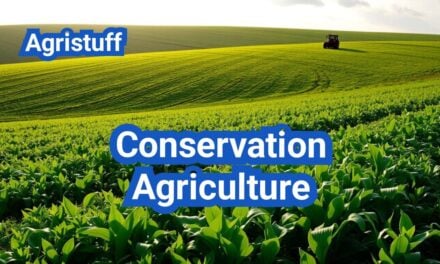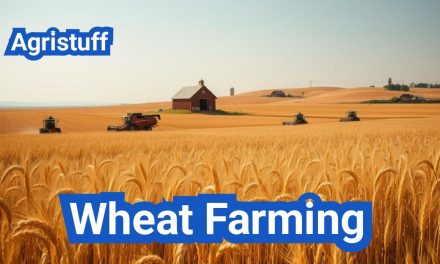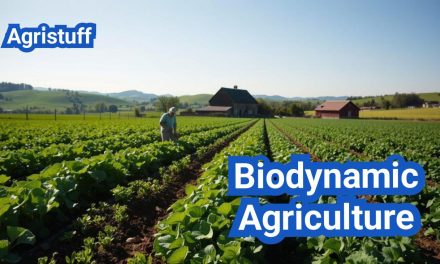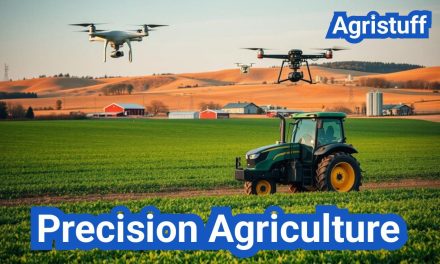Ecological farming, also known as bio farming, is an agricultural practice that focuses on restoring naturally occurring microorganisms and beneficial macro-organisms to the soil.
This approach facilitates soil viability and nutrient availability to crops, promoting a healthier ecosystem. By adopting sustainable agriculture methods, farmers can improve crop yields while minimizing environmental impact.
Bio farming is gaining popularity as a viable alternative to conventional farming practices, offering numerous benefits, including improved soil health and biodiversity.
Key Takeaways
- Bio farming focuses on restoring microorganisms and beneficial macro-organisms to the soil.
- This approach promotes soil viability and nutrient availability to crops.
- Sustainable agriculture methods improve crop yields while minimizing environmental impact.
- Bio farming offers numerous benefits, including improved soil health and biodiversity.
- Ecological farming is a viable alternative to conventional farming practices.
What Is Bio Farming?
By definition, bio farming involves using a combination of conventional and organic farming practices to achieve optimal soil health, resulting in healthier crops and livestock.
Definition and Core Principles
Bio farming is characterized by its focus on ecological balance and biodiversity. The core principles include working with natural cycles, maintaining soil health through composting and cover cropping, and integrating livestock into farming systems.
A key aspect of bio farming is its emphasis on creating a self-sustaining ecosystem. This involves:
- Using natural pest control methods
- Implementing crop rotation and intercropping
- Maintaining ecological balance
The Philosophy Behind Bio Farming
The philosophy of bio farming is rooted in the belief that the health of the soil, plants, animals, and humans are interconnected. This approach is influenced by biodynamic agriculture, a concept developed by Rudolf Steiner that considers the farm as a living organism.
“The farm is a living, breathing entity that must be managed in a way that respects its inherent rhythms and relationships.” – Rudolf Steiner
Bio Farming in the Modern Agricultural Landscape
In today’s agricultural landscape, bio farming offers a sustainable alternative to conventional farming methods. By focusing on soil health and ecological balance, bio farmers can improve the nutritional quality of their produce while minimizing environmental impact.
| Aspect | Conventional Farming | Bio Farming |
|---|---|---|
| Soil Management | Often relies on synthetic fertilizers | Uses natural methods like composting |
| Pest Control | Frequently uses chemical pesticides | Employs natural pest control methods |
As the world grapples with the challenges of climate change, environmental degradation, and food security, bio farming presents a promising path forward. By adopting bio farming practices, farmers can contribute to a more sustainable food system.
The History and Evolution of Bio Farming

Understanding the evolution of bio farming requires a journey through its historical milestones and pioneering figures. Bio farming, in its various forms, has roots that stretch back to the early 20th century when agricultural practices began to shift in response to industrialization.
Origins of Biological Agriculture
The origins of biological agriculture are closely tied to the work of pioneers who sought to understand and work with natural ecosystems rather than against them. This approach was partly a reaction to the increasing use of chemical fertilizers and pesticides, which were seen as detrimental to soil health and biodiversity.
Key principles of early biological agriculture included:
- Working in harmony with nature
- Maintaining soil fertility through organic means
- Promoting biodiversity on farms
Rudolf Steiner and Biodynamic Agriculture
A significant figure in the development of bio farming is Rudolf Steiner, an Austrian philosopher who laid the groundwork for biodynamic agriculture in the 1920s. Steiner’s approach was holistic, considering the farm as a self-contained ecosystem influenced by celestial rhythms.
Biodynamic agriculture, as developed by Steiner, includes practices such as:
- Using specific preparations to enhance soil and plant health
- Planting according to lunar and celestial cycles
- Integrating livestock into the farming system
Development of Bio Farming in the United States
The development of bio farming in the United States was influenced by European practices, including biodynamic agriculture. American farmers and researchers began to adopt and adapt these methods, focusing on organic and sustainable practices.
The evolution of bio farming in the U.S. involved:
- The establishment of organic farming associations and certification programs
- Research into sustainable agricultural practices
- Growing consumer demand for organic and sustainably produced foods
Bio Farming vs. Organic Farming: Understanding the Differences
Understanding the nuances between bio farming and organic farming is crucial for farmers and consumers alike. While both methods eschew synthetic chemicals, their approaches to sustainability and ecosystem management differ significantly.
Similarities in Practices and Philosophy
Both bio farming and organic farming share a commitment to natural practices and avoiding synthetic fertilizers and pesticides. They emphasize the importance of soil health, biodiversity, and ecological balance. Soil conservation and composting are common practices in both methods, aimed at enhancing soil fertility naturally.
Many farmers and consumers choose between bio and organic farming based on their specific goals and values. For instance, both methods are geared towards producing high-quality, nutritious food while minimizing environmental impact.
Key Distinctions Between Bio and Organic Methods
The primary difference lies in their approach to creating a sustainable ecosystem. Bio farming focuses on developing a self-sustaining ecosystem on the farm, often incorporating biodynamic principles. In contrast, organic farming primarily focuses on avoiding synthetic inputs.
| Aspect | Bio Farming | Organic Farming |
|---|---|---|
| Approach | Focuses on creating a self-sustaining ecosystem | Avoids synthetic inputs |
| Philosophy | Incorporates biodynamic principles | Emphasizes natural inputs and practices |
| Certification | Often Demeter certification for biodynamic farms | USDA Organic certification |
Choosing the Right Approach for Your Goals
When deciding between bio farming and organic farming, consider your farm’s specific needs and your personal values. If creating a holistic, self-sustaining ecosystem is a priority, bio farming might be the more suitable choice. Conversely, if your primary concern is avoiding synthetic chemicals, organic farming could be more appropriate.
It’s also worth considering the certification processes and market demands associated with each method. For instance, Demeter certification is often associated with biodynamic farms, while USDA Organic is a well-known standard for organic produce.
Biodynamic Farming: A Holistic Approach

Biodynamic farming represents a holistic approach to agriculture, integrating the health of soil, plants, and the cosmos. This method views the farm as a self-contained ecosystem where every element interacts and influences the others.
Core Principles
The core principles of biodynamic agriculture are centered around creating a balanced and diverse farm ecosystem. This involves using biodynamic preparations to enhance soil and plant health, as well as considering cosmic rhythms in planting decisions.
Biodynamic Preparations are special concoctions made from natural materials like cow manure, silica, and herbs. These preparations are used to enhance soil fertility and plant growth.
Biodynamic Preparations and Their Applications
Biodynamic preparations are applied in very small quantities, often in a homeopathic manner. For example, horn manure preparation is made by filling a cow horn with manure and burying it in the ground during winter. It’s then dug up and used to stimulate root growth.
| Preparation | Description | Application |
|---|---|---|
| Horn Manure | Made from cow manure buried in a horn | Stimulates root growth |
| Silica Preparation | Made from silica and quartz | Enhances plant vitality |
Cosmic Rhythms and Planting Calendars
Biodynamic farming also considers cosmic rhythms and their influence on plant growth. Planting calendars are often used to determine the optimal times for planting, harvesting, and other farm activities based on lunar and planetary positions.
“The farmer sows not seeds, but a rhythm, a cosmic rhythm that is attuned to the universe.” –
Rudolf Steiner
By following these cosmic rhythms, farmers can potentially improve crop yields and overall farm health.
Essential Principles of Bio Farming
At its core, bio farming involves understanding and respecting the natural world to foster a healthy and thriving farm ecosystem. This approach to agriculture is guided by several key principles that work together to create a balanced and sustainable farming environment.
Working with Natural Cycles and Rhythms
Bio farming emphasizes the importance of aligning agricultural practices with natural cycles and rhythms. This includes observing lunar cycles, understanding soil biology, and respecting the natural growth patterns of plants and animals. By working in harmony with these natural cycles, bio farmers can enhance the overall health and productivity of their farms.
Key practices include:
- Planting according to lunar and solar cycles
- Understanding and managing soil microbiota
- Observing and responding to weather patterns
Farm as a Self-Sustaining Organism
A bio farm is viewed as a self-sustaining organism, where all components work together to create a balanced ecosystem. This principle encourages farmers to diversify their crops, integrate livestock, and minimize external inputs.
The benefits of this approach include:
- Increased biodiversity
- Improved soil health
- Enhanced ecosystem services
Biodiversity and Ecological Balance
Biodiversity is a cornerstone of bio farming, as it promotes ecological balance and resilience. By cultivating a diverse range of crops and maintaining ecological habitats, bio farmers can create a robust and adaptable farming system.
| Biodiversity Practices | Ecological Benefits |
|---|---|
| Polyculture farming | Increased crop resilience |
| Habitat creation for beneficial insects | Natural pest control |
| Diverse crop rotation | Improved soil fertility |
By embracing these essential principles, bio farmers can create thriving, sustainable agricultural systems that benefit both the environment and their communities.
Soil Management in Bio Farming
In bio farming, the importance of soil management cannot be overstated, as it lays the foundation for a resilient and thriving agricultural system. Effective soil management practices are crucial for maintaining soil health, enhancing fertility, and promoting biodiversity.
Building Soil Health and Fertility Naturally
Building soil health and fertility naturally is a cornerstone of bio farming. This involves using techniques that enhance soil structure, increase organic matter, and promote beneficial microbial activity. Some key strategies include:
- Adding Organic Matter: Incorporating compost, manure, or green manures to improve soil fertility and structure.
- Minimizing Soil Disturbance: Reducing tillage to preserve soil organic matter and prevent erosion.
- Crop Rotation and Diversity: Rotating crops and incorporating a diverse range of plants to promote soil health and biodiversity.
Composting Techniques for Bio Farmers
Composting is a vital practice in bio farming, as it converts waste organic materials into a valuable resource that enhances soil fertility and structure. Effective composting techniques include:
- Aerobic Composting: Ensuring adequate oxygen supply to promote aerobic decomposition and reduce odors.
- Layering: Creating compost piles with alternating layers of ‘green’ (nitrogen-rich) and ‘brown’ (carbon-rich) materials.
- Monitoring Moisture: Maintaining optimal moisture levels to support microbial activity.
Cover Cropping and Green Manures
Cover cropping and the use of green manures are essential practices in bio farming for enhancing soil health. Cover crops help protect the soil from erosion, improve soil structure, and increase biodiversity. Green manures, typically leguminous crops, are incorporated into the soil to add nutrients and organic matter.
Some popular cover crops include clover, rye, and vetch, which can be used in rotation to maximize benefits. By integrating cover cropping and green manures into their farming systems, bio farmers can improve soil fertility, reduce the need for synthetic fertilizers, and promote a more sustainable agricultural practice.
Bio-Intensive Agriculture Methods

Bio-intensive agriculture is a farming approach that focuses on maximizing yields while minimizing land use. This method is particularly beneficial for small-scale farmers or those with limited land resources.
Deep Soil Preparation Techniques
One of the core principles of bio-intensive agriculture is deep soil preparation. This involves loosening the soil to a depth of at least 24 inches to improve root growth and increase soil aeration. Deep soil preparation also enhances water infiltration and retention, reducing the need for irrigation.
To achieve deep soil preparation, farmers can use techniques such as double digging or trenching. These methods involve removing the topsoil, loosening the subsoil, and then replacing the topsoil. This process not only improves soil structure but also enhances its fertility.
Companion Planting and Polycultures
Another key aspect of bio-intensive agriculture is the use of companion planting and polycultures. Companion planting involves growing different crops together to improve growth, reduce pests and diseases, and enhance biodiversity. Polycultures, on the other hand, involve growing multiple crops together in the same space, mimicking natural ecosystems.
Examples of beneficial companion planting include pairing marigolds with tomatoes to deter nematodes, or planting beans with corn and squash (the “Three Sisters”) to create a symbiotic relationship that enhances growth and reduces pests.
Maximizing Yields in Small Spaces
Bio-intensive agriculture is particularly suited for small-scale farming due to its focus on maximizing yields in limited spaces. Techniques such as vertical gardening, intensive planting, and succession planting can significantly increase productivity.
For instance, using trellises or cages for climbing plants like peas or beans can make efficient use of space. Similarly, succession planting ensures a continuous harvest by staggering the planting of crops.
Implementing Bio-Diverse Farming Practices

Enhancing biodiversity on farms is a key strategy for improving ecological balance. Bio-diverse farming practices not only contribute to a healthier environment but also increase the resilience of farming systems. By adopting these practices, farmers can create more sustainable and productive farms.
Creating Beneficial Habitats
Creating beneficial habitats is a crucial aspect of bio-diverse farming. This involves designing and managing ecosystems that support a wide range of plant and animal species. By doing so, farmers can enhance pollination, improve pest control, and increase overall biodiversity.
Some effective strategies for creating beneficial habitats include:
- Planting native vegetation along field borders and waterways
- Creating hedgerows to provide habitat for beneficial insects
- Establishing pollinator gardens to support bee populations
Integration of Livestock and Crops
Integrating livestock and crops is another key component of bio-diverse farming. This approach, known as integrated farming systems, can enhance nutrient cycling, improve soil health, and increase overall farm productivity.
| Benefits | Crop Production | Livestock Integration |
|---|---|---|
| Nutrient Cycling | Crop rotation enhances soil fertility | Livestock manure acts as natural fertilizer |
| Pest Control | Crop diversity reduces pest pressure | Livestock can help control pests through grazing |
| Ecosystem Services | Crops provide habitat for beneficial insects | Livestock grazing maintains ecosystem balance |
Enhancing Biodiversity on Your Farm
Enhancing biodiversity on your farm involves a combination of strategies that promote ecological balance and resilience. This can include practices such as agroforestry, conservation tillage, and the use of cover crops.
By implementing these practices, farmers can not only improve the health of their farm ecosystems but also contribute to broader environmental goals, such as carbon sequestration and wildlife conservation.
Pest and Disease Management in Bio Farming

Managing pests and diseases is a significant challenge in bio farming, necessitating a holistic approach. Bio farmers must adopt a combination of strategies to protect their crops while maintaining the ecological integrity of their farms.
Natural Predators and Beneficial Insects
One of the cornerstones of pest management in bio farming is the use of natural predators and beneficial insects. These organisms help control pest populations naturally, reducing the need for chemical pesticides. For example, ladybugs are known to prey on aphids, while lacewings feed on whiteflies and other pests. By creating a welcoming environment for these beneficial insects, bio farmers can significantly reduce pest pressure.
To attract natural predators, farmers can plant a diverse range of flora around their fields. This not only provides habitat and food for beneficial insects but also enhances biodiversity on the farm. Additionally, avoiding broad-spectrum pesticides is crucial, as these can harm beneficial insects along with the pests.
Bio Pesticides and Their Proper Use
When pest pressure is high, bio pesticides can be an effective tool for bio farmers. These are derived from natural materials such as plants, bacteria, and certain minerals. Examples include neem oil, pyrethrin, and Bt toxin. It’s essential to use these products judiciously, following label instructions carefully to minimize impact on non-target organisms.
The proper use of bio pesticides involves identifying the pest correctly, choosing the appropriate product, and applying it at the right time. This targeted approach helps minimize the development of resistance in pest populations and reduces the risk of harming beneficial organisms.
Preventative Strategies for Plant Health
Prevention is a key aspect of pest and disease management in bio farming. Strategies include selecting crop varieties that are resistant to specific pests or diseases, practicing good sanitation, and ensuring optimal growing conditions through proper soil management and irrigation practices.
Crop rotation and intercropping are also valuable preventative strategies. These practices can break the life cycle of pests and diseases, improve soil health, and enhance biodiversity. By diversifying the crops grown, bio farmers can create a more resilient farming system that is better equipped to withstand pest and disease pressures.
Using Bio Fertilizers and Soil Amendments

The use of bio fertilizers and soil amendments is a key practice in bio farming, promoting a healthy and sustainable agricultural ecosystem. These natural substances enhance soil fertility, improve plant health, and contribute to a balanced ecosystem.
Types of Bio Fertilizers
Bio fertilizers are living microorganisms that, when applied to the soil, promote plant growth by increasing the availability of nutrients. The most common types include:
- Rhizobia: These bacteria form symbiotic relationships with legume roots, fixing atmospheric nitrogen into a form that plants can use.
- Mycorrhizal fungi: These fungi enhance nutrient uptake by plants, improving their resistance to diseases and drought.
- Azospirillum: These bacteria are known for their ability to fix nitrogen and produce growth-promoting substances.
These bio fertilizers can be applied directly to the soil or used as seed coatings, depending on the specific requirements of the crop.
Making and Applying Compost Tea
Compost tea is a liquid solution made by steeping compost in water. It’s a valuable tool for bio farmers, as it:
- Provides beneficial microbes to the soil
- Enhances soil structure and fertility
- Promotes healthy plant growth
To make compost tea, high-quality compost is steeped in water, typically in a ratio of 1:10 (compost:water), for 24-48 hours. The solution is then applied to the soil or used as a foliar spray.
Mineral Amendments in Bio Farming
Mineral amendments are naturally occurring substances that can be used to improve soil health. Common mineral amendments include:
- Rock dust: Rich in micronutrients, rock dust can help replenish soil minerals.
- Gypsum: Improves soil structure and provides calcium and sulfur.
- Lime: Used to adjust soil pH and provide calcium.
These amendments should be used judiciously, based on soil testing to determine specific nutrient needs.
By incorporating bio fertilizers and soil amendments into their practices, bio farmers can enhance soil fertility, promote plant health, and contribute to a more sustainable agricultural system.
Transitioning to Bio Farming: A Step-by-Step Guide

For farmers considering bio farming, the first step is to assess their land’s suitability and develop a comprehensive transition plan. Transitioning to bio farming is a journey that requires patience, dedication, and a thorough understanding of biodynamic principles.
Assessing Your Land and Resources
Before starting your bio farming journey, it’s crucial to assess your land’s potential. This involves evaluating soil health, biodiversity, and existing ecosystem services. Soil testing is a critical step to understand your soil’s nutrient profile and structure.
Consider factors such as:
- Topography and drainage
- Existing vegetation and biodiversity
- Climate and microclimate conditions
- Access to water resources
As noted by Masanobu Fukuoka, a pioneer in natural farming, “The ultimate goal of farming is not the growing of crops, but the cultivation and perfection of human beings.” This philosophy underscores the importance of harmonizing with nature when assessing and managing your land.
Creating a Bio Farm Plan
A well-structured bio farm plan is essential for a successful transition. This plan should outline your farm’s goals, strategies for achieving those goals, and a timeline for implementation.
Key components of a bio farm plan include:
- Crop rotation and polyculture strategies
- Soil management and conservation techniques
- Biodiversity enhancement plans
- Integration of livestock and crop production
“The farm is a living organism, and like any organism, it needs to be in balance to be healthy and productive,” says a renowned biodynamic farmer. This balance is achieved through careful planning and continuous observation.
Timeline and Expectations for Conversion
Transitioning to bio farming is a process that takes time. The timeline for conversion can vary depending on factors such as the size of your farm, the condition of your soil, and your level of experience with biodynamic practices.
Typically, the conversion process can take several years. It’s essential to have realistic expectations and be prepared to adapt your plan as needed based on observations and results.
A quote from
“The earth is not a dead piece of matter but a living organism. We must respect it and not try to conquer it.” –
Albert Howard
resonates with the philosophy of bio farming, emphasizing the need for a harmonious relationship with nature.
Water Management in Bio Farming

Water management plays a vital role in bio farming, encompassing conservation, efficient irrigation, and rainwater harvesting. Effective water management is essential for maintaining the health and productivity of bio farms.
Conservation Techniques
Conservation techniques are critical in bio farming to minimize water waste and optimize its use. Soil conservation methods, such as mulching and cover cropping, help retain soil moisture and reduce erosion. Additionally, crop rotation and polycultures can enhance soil’s water-holding capacity.
Irrigation Methods for Bio Farms
Efficient irrigation methods are vital for bio farming. Techniques such as drip irrigation and sprinkler systems deliver water directly to the roots of plants, minimizing evaporation and runoff. Precision irrigation, which involves using technology to monitor soil moisture levels, can further optimize water use.
Rainwater Harvesting Systems
Rainwater harvesting is another crucial aspect of water management in bio farming. By collecting and storing rainwater, farmers can reduce their reliance on other water sources during dry periods. Rainwater harvesting systems can be designed to collect runoff from roofs or fields, storing it in tanks or ponds for later use.
Certification and Standards for Bio Farming

The journey to becoming a certified bio farm involves navigating through various standards and regulations. Bio farming certification is not just about compliance; it’s a way to ensure that farming practices are sustainable, ethical, and of high quality.
Demeter Certification for Biodynamic Farms
Demeter certification is one of the most recognized standards for biodynamic farms. To achieve Demeter certification, farms must adhere to strict guidelines that go beyond organic practices, focusing on the farm as a self-sustaining ecosystem.
Key Requirements for Demeter Certification:
- Use of biodynamic preparations
- Integration of crops and livestock
- Maintenance of ecological balance
USDA Organic and Bio Farming Overlap
While bio farming and USDA organic farming share many similarities, there are distinct differences. USDA organic certification primarily focuses on the prohibition of synthetic substances, whereas bio farming encompasses a broader range of practices, including biodiversity and ecological balance.
| Certification | Focus | Key Practices |
|---|---|---|
| Demeter | Biodynamic farming | Biodynamic preparations, crop rotation |
| USDA Organic | Prohibition of synthetic substances | Organic fertilizers, no GMOs |
Record-Keeping Requirements
Regardless of the certification, meticulous record-keeping is crucial. Records should detail farming practices, inputs used, and sales. This not only helps in maintaining transparency but also in tracing the origin of products.
Effective record-keeping involves maintaining detailed logs of activities such as planting, harvesting, and application of fertilizers or pest control measures. This data is essential for audits and certification renewals.
Marketing and Selling Bio-Farmed Products
Marketing bio-farmed products effectively involves building a strong brand identity and connecting with conscious consumers. Bio farmers need to differentiate their products in a competitive market by highlighting the unique qualities and benefits of bio farming.
Building Your Brand Identity
A strong brand identity is crucial for bio farmers to establish a loyal customer base. This involves creating a unique brand story, logo, and visual identity that reflects the values and practices of bio farming.
Key elements of a strong brand identity include:
- Clear communication of bio farming practices
- Emphasis on sustainability and environmental stewardship
- Highlighting the nutritional benefits of bio-farmed products
Direct Marketing Strategies
Direct marketing allows bio farmers to connect directly with consumers, build relationships, and promote their products effectively. Strategies include:
- Farmers’ markets and local events
- Community Supported Agriculture (CSA) programs
- Online platforms and social media
By leveraging these channels, bio farmers can increase their visibility and attract customers who value sustainable and healthy food options.
Connecting with Conscious Consumers
Conscious consumers prioritize the environmental and social impact of their purchasing decisions. Bio farmers can connect with these consumers by:
- Sharing the story behind their farming practices
- Highlighting the ecological benefits of bio farming
- Engaging in transparent and honest marketing communications
| Marketing Strategy | Description | Benefits |
|---|---|---|
| Farmers’ Markets | Direct sales to consumers at local markets | Increased visibility, customer engagement |
| CSA Programs | Consumers purchase shares of the farm’s produce | Stable income, customer loyalty |
| Social Media | Online engagement and product promotion | Broad reach, cost-effective marketing |
By implementing these strategies, bio farmers can effectively market their products, build a loyal customer base, and contribute to a more sustainable food system.
Environmental and Health Benefits of Bio Farming
By adopting bio farming methods, farmers can significantly contribute to environmental conservation and public health. Bio farming is a holistic approach that not only enhances the sustainability of agricultural practices but also promotes ecological balance and biodiversity.
Soil Carbon Sequestration
One of the significant environmental benefits of bio farming is its potential for soil carbon sequestration. Practices such as using cover crops, incorporating organic amendments, and minimizing tillage help in building soil organic matter, which in turn sequesters carbon from the atmosphere. This not only mitigates climate change but also improves soil health and fertility.
- Enhanced soil structure and water retention
- Increased biodiversity in soil ecosystems
- Improved nutrient cycling and availability
Water Quality Improvements
Bio farming also contributes to water quality improvements by reducing the use of synthetic fertilizers and pesticides, which can pollute water bodies. Techniques like crop rotation, buffer strips, and conservation tillage help in minimizing runoff and maintaining water quality.
- Reduced chemical runoff into water bodies
- Increased water infiltration and retention
- Protection of aquatic ecosystems
Nutritional Benefits of Bio-Farmed Foods
Bio-farmed foods are known for their nutritional benefits. The practices involved in bio farming, such as using natural amendments and maintaining soil health, result in produce that is rich in nutrients and free from harmful chemicals. Consumers of bio-farmed products often report better taste and higher satisfaction.
| Nutritional Aspect | Bio-Farmed Foods | Conventionally Grown Foods |
|---|---|---|
| Vitamin Content | Higher | Variable |
| Mineral Content | Rich in minerals | May lack certain minerals |
In conclusion, bio farming offers a multitude of benefits, from environmental conservation through soil carbon sequestration and water quality improvements, to health benefits through more nutritious food. As the world moves towards more sustainable agricultural practices, bio farming stands out as a promising approach.
The Future of Bio Farming
As concern for environmental sustainability grows, bio farming is poised to play a significant role in the future of agriculture. By embracing ecological farming practices, farmers can contribute to a more sustainable food system while promoting biodiversity and ecological balance.
The future of bio farming looks promising, with its focus on working with natural cycles and rhythms, creating self-sustaining ecosystems, and minimizing the use of synthetic inputs. As consumers become more conscious of the environmental and health impacts of their food choices, the demand for bio-farmed products is likely to increase, driving growth in this sector.
Sustainable agriculture practices like bio farming will be crucial in addressing the challenges posed by climate change, soil degradation, and water scarcity. By adopting these methods, farmers can help sequester carbon, improve soil health, and conserve water resources, ultimately contributing to a more resilient agricultural system.
FAQ
What is bio farming, and how does it differ from conventional agriculture?
Bio farming is an agricultural approach that emphasizes working with natural cycles and rhythms, creating a self-sustaining farm ecosystem, and maintaining biodiversity and ecological balance. It differs from conventional agriculture in its holistic and sustainable methods.
What is biodynamic agriculture, and how did it originate?
Biodynamic agriculture is a form of bio farming that was developed by Rudolf Steiner. It is based on the idea that the farm is a living organism and emphasizes the use of biodynamic preparations, cosmic rhythms, and a holistic approach to agricultural systems.
How does bio farming compare to organic farming?
Bio farming and organic farming share similarities in their emphasis on natural and sustainable practices. However, bio farming goes beyond organic farming by considering the farm as a self-sustaining organism and incorporating biodynamic preparations and cosmic rhythms.
What are the core principles of bio farming?
The core principles of bio farming include working with natural cycles and rhythms, creating a self-sustaining farm ecosystem, and maintaining biodiversity and ecological balance.
What is the role of biodynamic preparations in bio farming?
Biodynamic preparations are a key component of biodynamic agriculture and are used to enhance soil health, promote biodiversity, and create a balanced ecosystem.
How can I implement bio farming on my land?
To implement bio farming, start by assessing your land and resources, creating a bio farm plan, and transitioning to sustainable and natural practices.
What are some essential bio farming practices?
Essential bio farming practices include composting, cover cropping, deep soil preparation, companion planting, and polycultures.
How does bio farming manage pests and diseases?
Bio farming manages pests and diseases through the use of natural predators, bio pesticides, and preventative measures such as crop rotation and maintaining a balanced ecosystem.
What are the environmental benefits of bio farming?
Bio farming offers numerous environmental benefits, including soil carbon sequestration, water quality improvements, and biodiversity enhancement.
How can I certify my bio farm?
Certification for bio farming can be obtained through programs such as Demeter certification for biodynamic farms and USDA Organic certification.
What are the health benefits of bio-farmed foods?
Bio-farmed foods offer numerous health benefits, including higher nutritional value and lower exposure to synthetic chemicals.
How does bio farming contribute to a more sustainable food system?
Bio farming contributes to a more sustainable food system by promoting ecological balance, biodiversity, and sustainable agricultural practices.
What is regenerative agriculture, and how does it relate to bio farming?
Regenerative agriculture is an approach to farming that focuses on regenerating soil health, promoting biodiversity, and enhancing ecosystem services. It is closely related to bio farming and shares many of the same principles and practices.
Conclusion of: Bio Farming
Bio farming, also known as organic farming, is a holistic agricultural approach focusing on producing food without synthetic chemicals or genetically modified organisms. It promotes ecological balance, conserves biodiversity, and enhances soil fertility using sustainable practices. Bio farming has gained immense popularity, particularly in the United States, as more consumers seek healthier and environmentally friendly food options. In this comprehensive guide, you’ll find everything you need to understand about bio farming.
What is Bio Farming?
Bio farming involves cultivating crops and raising livestock using natural processes. Instead of synthetic fertilizers and pesticides, bio farming relies on biological pest control, crop rotation, compost, and green manure. This approach ensures that the soil remains fertile and healthy for future farming activities, ultimately producing nutritious, chemical-free food.
An authoritative resource on organic farming can be found on the USDA’s official website USDA Organic Farming.
Benefits of Bio Farming
Bio farming offers numerous benefits, including improved soil health, better water conservation, and higher nutritional quality in produce. It reduces environmental pollution caused by chemicals, preserving ecosystems and promoting biodiversity. Additionally, bio farming supports local economies by encouraging sustainable agricultural practices.
For further insights, visit IFOAM Organics International for global perspectives and practices in organic farming.
Techniques Used in Bio Farming
Several effective techniques are prevalent in bio farming, including crop rotation, organic fertilization, composting, and biological pest control. Crop rotation prevents soil degradation and pest infestations. Organic fertilization, using manure and compost, enriches the soil naturally, and composting recycles organic waste into valuable nutrients.
The Rodale Institute provides detailed information on sustainable farming techniques at Rodale Institute.
Bio Farming Certification
In the United States, bio farming products must comply with USDA organic standards. Farms undergo rigorous inspections and certifications to market their produce as organic. Certification assures consumers of the authenticity and quality of bio farming products.
To understand the certification process better, check Organic Certification.
Challenges in Bio Farming
Despite its benefits, bio farming faces several challenges, including higher labor costs, initial lower yields, and vulnerability to pests and diseases without synthetic chemicals. Overcoming these challenges involves education, innovative techniques, and government support.
A deeper look into these challenges and solutions can be found through resources such as National Sustainable Agriculture Coalition.
Bio Farming Practices and Environment
Bio farming significantly contributes to environmental sustainability. It enhances soil quality, reduces greenhouse gas emissions, and promotes water conservation. By avoiding chemical inputs, bio farming also prevents pollution of waterways and ecosystems, thus benefiting wildlife and biodiversity.
For further information, explore resources available from Environmental Working Group regarding the environmental impacts of agriculture.
Market and Economic Impact of Bio Farming
The bio farming market has witnessed significant growth, driven by rising consumer demand for organic products. Organic foods often command premium prices, benefiting bio farmers economically. The market trend towards sustainability further bolsters bio farming’s economic viability.
Explore market trends and economic analysis on organic agriculture at Organic Trade Association.
Bio Farming and Health
Consuming bio farming products is linked to numerous health benefits, including reduced exposure to pesticides and potentially higher nutrient content. Organic farming practices contribute to healthier soil, plants, animals, and people.
Research and health-related insights on organic products are detailed at Harvard Health Publishing.
Transitioning to Bio Farming
Transitioning to bio farming requires careful planning, knowledge, and investment. Farmers need to adapt to new techniques, manage financial risks, and often overcome initial lower yields. Support and training from organic farming organizations can significantly ease this transition.
The Sustainable Agriculture Research and Education program offers guidance for transitioning farmers at SARE.
Bio Farming in the United States
Bio farming is growing rapidly in the United States, supported by consumer awareness, government policies, and farming innovations. American bio farming contributes significantly to sustainable food production and environmental conservation, reflecting the global shift toward healthier agriculture.
The USDA provides regular updates and statistics on organic farming in the USA USDA Organic Agriculture.
Final Thought
Bio farming represents an essential step toward sustainable agriculture. By fostering biodiversity, enhancing soil health, and promoting healthier food options, bio farming contributes significantly to ecological balance and human well-being. Embracing and supporting bio farming practices ensures a healthier planet and healthier future generations.










